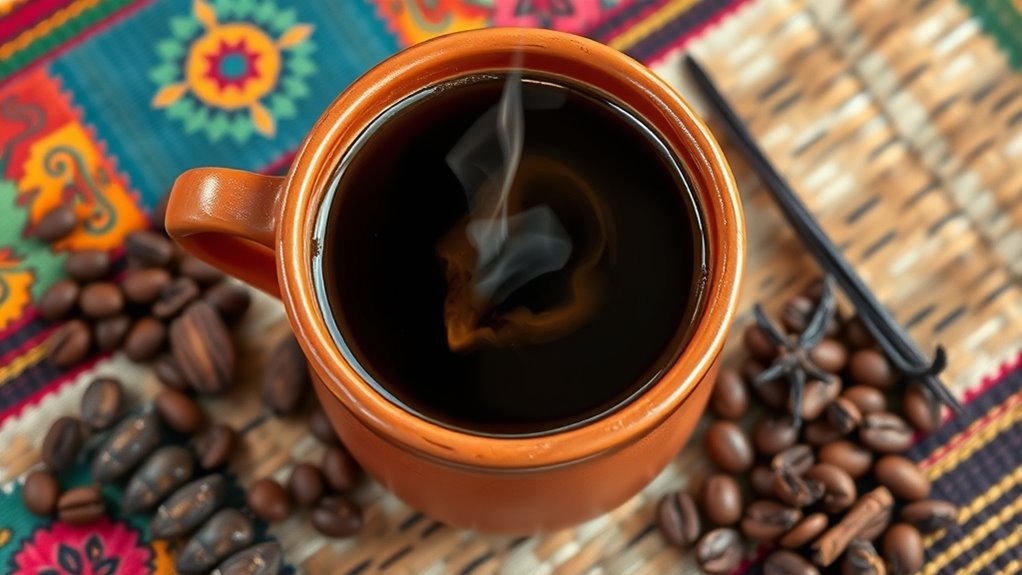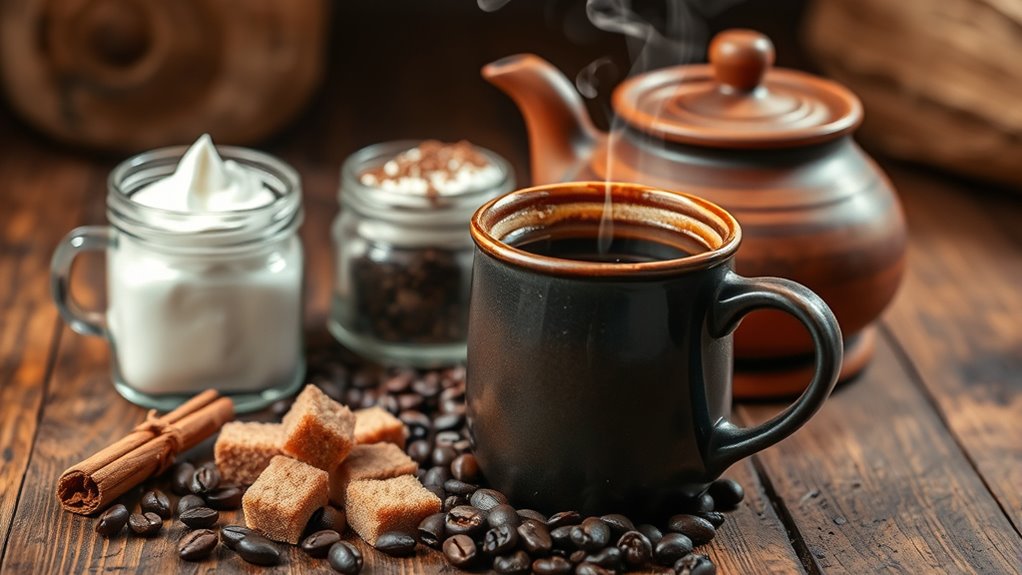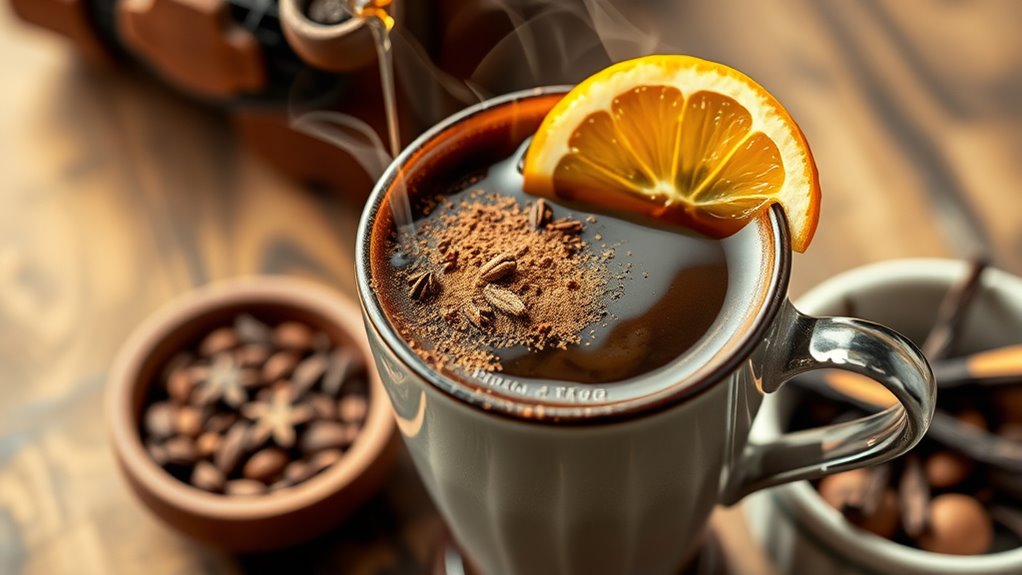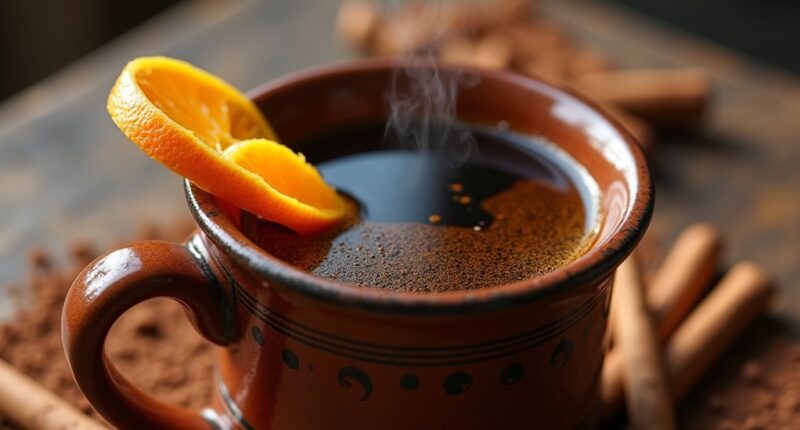Mexican coffee’s a tasty adventure! It’s made with dark-roasted beans for those rich, earthy vibes, then brewed in spiced water for an extra kick. Don’t forget the piloncillo, a sweetener that adds a caramel twist, plus spices like cinnamon and cloves for a cozy aroma. You can top it off with creamy evaporated milk or whipped cream, making it feel like a warm hug in a mug. There’s so much more to explore, so let’s dive deeper!
At a Glance
- Mexican coffee typically uses dark-roasted beans for rich, earthy flavors and aroma.
- It is brewed in spiced water with ingredients like piloncillo and cinnamon for enhanced taste.
- Traditional clay pots are often used to brew Mexican coffee, contributing to its unique flavor profile.
- Creamy additives like evaporated milk and whipped cream are common, along with spices for extra flavor.
- Regional variations like Chiapas and Oaxaca offer distinct flavor notes, from nutty to vibrant acidity.
Core Ingredients of Mexican Coffee

So, what makes Mexican coffee so special? It’s all about those traditional flavors!
You start with dark-roasted beans, which bring out rich, earthy notes. Picture that chocolatey goodness hitting your taste buds!
Dark-roasted beans deliver rich, earthy notes that create a chocolatey explosion of flavor with every sip!
It’s brewed in spiced water, infusing all those delightful flavors right from the start. You might even use a clay pot for that authentic vibe—how cool is that?
The coffee origins are steeped in culture, and every sip transports you to Mexico. Plus, when you grind it fresh, you get the best experience. Additionally, many Mexican coffee blends incorporate distinct flavor profiles that enhance the overall taste.
Trust me, once you try it, you’ll feel like part of the family!
Sweeteners and Spices
When you think about Mexican coffee, it’s not just the rich, dark beans that make it shine; it’s all those tasty sweeteners and spices that take it over the top! Piloncillo, a traditional sweetener, adds earthy caramel notes, and it’s been a staple for centuries. You can also spice it up with cinnamon, cloves, or even a hint of orange zest. Check this out:
| Sweetener Types | Spice Origins | Flavor Notes |
|---|---|---|
| Piloncillo | Cinnamon | Earthy, Caramel |
| Brown Sugar | Cloves | Aromatic, Spicy |
| Piloncillo Syrup | Vanilla, Anise | Sweet, Complex |
These flavors truly create a cozy, warm hug in a mug! Additionally, many people are discovering the benefits of low acid coffee, which can enhance the overall coffee experience without the harshness.
Brewing Method

There’s something magical about brewing Mexican coffee that makes the whole experience feel special.
You’ll love using these brewing techniques and infusion methods to create an authentic cup:
- Start with a clay pot for that earthy flavor (or a regular pan if you’re in a pinch).
- Infuse water with spices like cinnamon and piloncillo for a sweet touch.
- Let your coffee steep in the spiced syrup for that bold taste.
Additionally, using high-quality beans from the finest Mexican coffee brands can elevate your brewing experience to new heights.
Dairy and Add-Ins
Brewing that perfect cup of Mexican coffee is just the beginning of the adventure; it’s the dairy and add-ins that really take it over the top!
Imagine swirling in creamy evaporated milk or your favorite milk types like whole or almond—each brings its own flavor profiles.
Want to spice things up? Toss in some cinnamon and a dash of vanilla for warmth. You could even sweeten it with piloncillo for that caramel goodness!
Whipped cream on top? Yes, please! It’s all about finding what makes your taste buds dance. Additionally, consider using non-dairy creamers for a delightful twist that caters to various dietary preferences.
Variations and Substitutions

If you think all Mexican coffee is the same, think again! There are amazing regional differences and varietal characteristics that make each cup special. Here’s what to explore:
- Chiapas offers nutty, chocolate notes with smooth acidity.
- Veracruz brings floral aromas and moderate acidity from its highlands.
- Oaxaca surprises you with vibrant flavors and bright acidity.
Now, some brands even substitute lower-quality beans for those grown at altitude, improving flavor. Additionally, many Mexican coffee varieties are renowned for their unique flavor profiles, which can elevate your coffee experience.
Dark roasts can tone down acidity, perfect for sensitive stomachs.
Cultural and Practical Notes
When you think about Mexican coffee, it’s not just about the beans; it’s about the whole vibe that comes with it!
Imagine this: you’re at a family gathering, Café de Olla bubbling in a clay pot, filling the air with warm, spicy aromas. This drink isn’t just coffee; it’s got cultural significance, bringing everyone together in communal traditions.
The blend of piloncillo and cinnamon creates a cozy hug in a cup! Additionally, the rich flavors of Kenyan coffee can also inspire new iterations of traditional recipes, blending cultures through unique coffee experiences.





